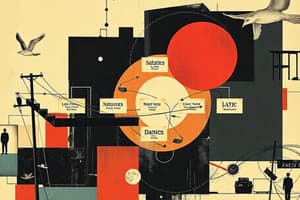Podcast
Questions and Answers
What is a characteristic feature of a hierarchical organizational structure?
What is a characteristic feature of a hierarchical organizational structure?
- Multiple levels of management (correct)
- Organization by product lines
- Decentralized decision-making
- Few levels of management
Which leadership style is characterized by centralizing decision-making and making unilateral decisions?
Which leadership style is characterized by centralizing decision-making and making unilateral decisions?
- Transactional
- Laissez-Faire
- Democratic
- Autocratic (correct)
In which organizational structure do employees report to multiple managers?
In which organizational structure do employees report to multiple managers?
- Flat
- Functional
- Divisional
- Matrix (correct)
What is a key feature of transformational leadership?
What is a key feature of transformational leadership?
Which type of organizational structure promotes employee autonomy and has minimal management levels?
Which type of organizational structure promotes employee autonomy and has minimal management levels?
What does the span of control refer to in an organizational context?
What does the span of control refer to in an organizational context?
Which leadership style involves teamwork and collaboration in decision-making?
Which leadership style involves teamwork and collaboration in decision-making?
What distinguishes a divisional organizational structure from others?
What distinguishes a divisional organizational structure from others?
Which statement reflects a principle of centralization in organizational structure?
Which statement reflects a principle of centralization in organizational structure?
Which leadership style allows employees significant freedom in their work with minimal supervision?
Which leadership style allows employees significant freedom in their work with minimal supervision?
Study Notes
Organizational Structure
- Definition: The way in which tasks, responsibilities, and authority are allocated within an organization.
- Types of Structures:
- Hierarchical: A top-down approach with multiple levels of management.
- Flat: Few or no levels of management; promotes employee autonomy.
- Matrix: Combines functional and project-based structures; employees report to multiple managers.
- Divisional: Organized by product lines, geographic regions, or markets.
- Functional: Groups employees based on specialized activities (e.g., marketing, finance).
- Key Features:
- Chain of Command: Defines the line of authority in an organization.
- Span of Control: Refers to the number of employees a manager supervises.
- Centralization vs. Decentralization: Degree to which decision-making is concentrated at the top (centralized) or distributed (decentralized).
- Impacts on Performance: A well-defined structure can lead to improved communication, efficiency, and employee satisfaction.
Leadership Styles
- Definition: The manner in which leaders motivate, direct, and manage their teams.
- Common Styles:
- Autocratic: Centralized decision-making; leaders make decisions unilaterally.
- Democratic: Involves team input in decision-making; encourages collaboration.
- Laissez-Faire: Minimal supervision; employees have significant freedom in how they work.
- Transformational: Inspires and motivates employees to innovate and change; focuses on vision and personal development.
- Transactional: Based on clear exchanges; rewards are given for performance.
- Key Considerations:
- Situational Leadership: The effectiveness of a style may vary depending on the context and team dynamics.
- Emotional Intelligence: A leader’s ability to understand and manage emotions affects team engagement and effectiveness.
- Cultural Impact: Leadership styles may be influenced by organizational culture and employee expectations.
Summary
- Organizational Structure: Shapes how activities are directed and managed; affects efficiency and communication.
- Leadership Styles: Influence team motivation and performance; the right style depends on the situation and team needs.
Organizational Structure
- Definition: Framework allocating tasks, responsibilities, and authority within an organization.
- Types of Structures:
- Hierarchical: Multi-level management that follows a top-down approach for decision-making.
- Flat: Minimal management levels; empowers employees and fosters autonomy.
- Matrix: Integrates functional and project-based frameworks; employees have multiple reporting lines.
- Divisional: Organized by specific products, geographic areas, or market segments.
- Functional: Groups personnel according to specialized operations such as marketing or finance.
- Key Features:
- Chain of Command: Establishes the line of authority within the organization.
- Span of Control: Indicates the number of subordinates a manager oversees.
- Centralization vs. Decentralization: Refers to the concentration of decision-making authority at the top (centralized) versus the distribution of power throughout the organization (decentralized).
- Impacts on Performance: A clear organizational structure enhances communication, boosts efficiency, and increases employee satisfaction.
Leadership Styles
- Definition: Techniques leaders use to motivate, direct, and manage teams.
- Common Styles:
- Autocratic: Leader exerts complete control; decisions are made independently without team input.
- Democratic: Team involvement in decision-making process; encourages collective input and collaboration.
- Laissez-Faire: Hands-off approach; provides employees with significant freedom to determine their work methods.
- Transformational: Encourages innovation and change through inspiration; emphasizes vision and personnel development.
- Transactional: Relies on clear rewards for performance; focuses on defined exchanges between leader and team.
- Key Considerations:
- Situational Leadership: Requires adaptability; effective leadership style varies with context and team dynamics.
- Emotional Intelligence: Critical for leaders; the ability to comprehend and manage emotions can significantly impact team engagement and productivity.
- Cultural Impact: Leadership styles may be shaped by the organization's culture and the expectations of employees.
Summary
- Organizational Structure: Crucial for directing activities; influences overall efficiency and communication capabilities.
- Leadership Styles: Affect team motivation and performance; the effectiveness of a style is contingent upon the situational context and the needs of the team.
Studying That Suits You
Use AI to generate personalized quizzes and flashcards to suit your learning preferences.
Description
Explore the various types of organizational structures, including hierarchical, flat, matrix, divisional, and functional. Understand key features like chain of command and span of control, and their impact on organizational performance. This quiz will help you grasp how structure influences management and efficiency.



